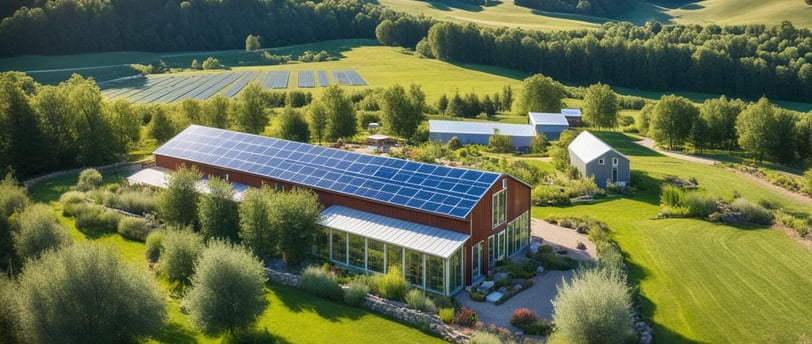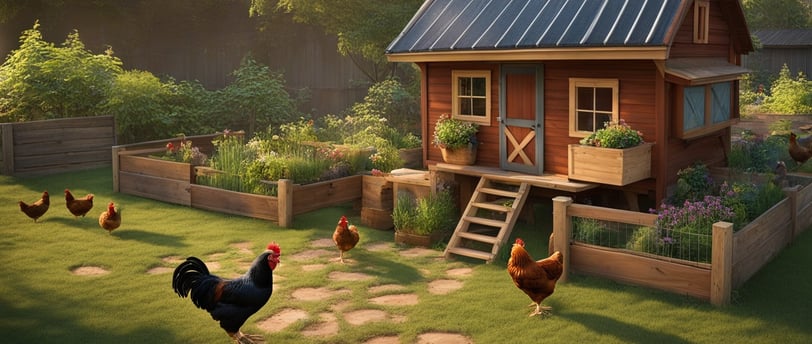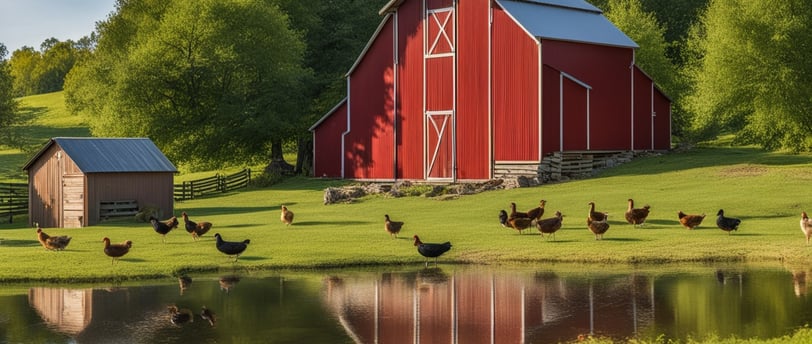Building a Self Sufficient Homestead: Your Guide
Discover the essentials of building a self-sufficient homestead, focusing on sustainable practices, resource management, and achieving independence through gardening, renewable energy, and DIY projects.
The Bug Out Bunker
8/27/202411 min read


Imagine waking up to the sound of chickens and the smell of fresh earth.
Building a self-sufficient homestead is more than a choice; it's a journey towards independence and harmony with nature.
It's a way to reconnect with the land and live by your values.
This guide will help you build your own self-sustaining paradise. You'll learn how to grow your own food, raise livestock, and preserve your harvest. You'll also learn about managing water and energy resources and using modern technology to live off the land. This guide is for anyone, whether you're new to homesteading or have been doing it for years.
Key Takeaways
Discover the benefits of living a self-sufficient lifestyle on a homestead
Learn how to assess your land and resources to plan your homestead goals
Explore sustainable food production methods, including growing your own vegetables and raising livestock
Understand the importance of water management and renewable energy sources for self-sufficiency
Gain practical skills and DIY projects to enhance your homesteading experience
Introduction to Self Sufficient Homesteading
Living on a self-sufficient homestead can change your life for the better. It means making your own food and energy, and using less from outside. You grow many crops, raise animals for food, and use the sun and wind for power.
What is a self-sufficient homestead?
A self-sufficient homestead is where people try to make most of their own food and resources. They aim for a greener lifestyle and better control over what they eat. Living this way, people feel more independent and happy.
Benefits of living off the land
Living off the land has many perks. You spend less money, live greener, and choose your food's quality. It also connects you closer to nature and boosts your independence.
"Homesteading has allowed me to live a more sustainable and fulfilling life. I take pride in providing for myself and my family, and the sense of freedom and self-sufficiency is unparalleled."
Reduced living costs
Sustainable, eco-friendly lifestyle
Control over food quality and source
Stronger connection to the natural world
Increased self-reliance and independence
Planning Your Homestead
Before starting your self-sufficient homesteading journey, it's key to assess your land and resources. Look at what your property offers and what it lacks. Think about soil quality, water sources, climate, and what's already there. This helps you see the best uses for your land.
Assessing Your Land and Resources
Check out your property's potential by looking at:
Soil quality and fertility for growing food
Availability and quality of water sources for irrigation and livestock
Microclimates and seasonal weather patterns that may impact homestead planning
Existing structures, utilities, and access roads that can be used
Understanding your land and resources helps you make smart choices about how to use your property.
Determining Your Homestead Goals
With a clear view of your land and resources, set goals for your homestead. Think about:
How self-sufficient you want to be (e.g., producing 50% of your own food)
Your family's needs, skills, and interests
Any legal or zoning rules in your area
Having a plan will help you turn your property into a thriving, self-sufficient homestead.
"The roots of self-sufficiency are deep, and the rewards are bountiful. By aligning your homestead goals with your land's potential, you'll create a sustainable future for yourself and your family."
Growing Food for Self-Sufficiency
Growing a variety of nutrient-rich foods is key to a self-sufficient homestead. The three sisters garden is a classic way to do this. It combines corn, beans, and squash in a way that helps each plant grow better.
The Three Sisters Garden: Corn, Beans, and Squash
This method, used by Native Americans, makes the three plants grow well together. Corn supports the beans, beans fix nitrogen for the plants, and squash keeps the soil moist. This approach creates a system that needs little care but gives a big harvest of important foods.
Potatoes and Other Root Vegetables
Along with the three sisters garden, growing potatoes and other root vegetables is vital for self-sufficiency. These plants are great for storing food through the winter. With good planning, homesteaders can grow a lot of these foods to feed their families all year.
"The three sisters garden is a time-honored technique that allows for sustainable, self-sufficient food production on the homestead."
Raising Livestock for Food and Products
Adding livestock to your homestead is key to being self-sufficient. Raising backyard chickens and small-scale chicken farming are great choices. They give you eggs and meat. Keeping hens and raising broiler chickens means you always have protein.
Using mobile chicken tractors and rotating pastures helps your chickens thrive. This makes your chicken farm more productive and sustainable.
Looking to grow your self-sufficient lifestyle? Consider raising dairy cows and homestead beef production. A milk cow gives you fresh dairy like milk, butter, cheese, and yogurt. Raising a beef cow lets you make your own quality meat.
Good care, managing pastures, and knowing how to process the animals are important. They help you succeed with cows on your homestead.
"The true purpose of education is to teach a man to carry himself triumphant through all his days." - Ralph Waldo Emerson
Choosing to focus on chickens, cows, or both can be rewarding. Adding these animals to your homestead is fulfilling and empowering. With the right knowledge and effort, you can create a thriving homestead. It meets your family's needs.



Preserving and Storing Your Harvest
As a self-sufficient homesteader, learning how to preserve and store food is key. It helps keep a steady supply of meals all year. By using food preservation techniques, you can make sure your hard work pays off. This keeps your fruits, vegetables, meats, and dairy fresh for longer. It helps with your homestead food storage and self-sufficient food supply.
Canning is a popular way to preserve food. It seals jars with produce, meats, and soups, keeping them fresh for a long time. Dehydrating is also great. It turns your harvest into snacks and ingredients that last longer and are full of nutrients.
Canning: Preserving the bounty in airtight jars
Dehydrating: Transforming fresh produce into shelf-stable snacks and ingredients
Freezing: Locking in freshness for long-term storage
Root cellaring: Harnessing the power of cool, dark spaces to preserve produce
Root cellaring is a method for keeping food fresh for months. It uses the earth's natural insulation to keep potatoes, carrots, apples, and other hardy crops fresh. Freezing is great for perishable items like meats and dairy. It lets you enjoy your harvest even in the off-season.
"Preserving the abundance of your homestead is the key to maintaining a self-sufficient food supply year-round."
Using different food preservation techniques in your homesteading can make your hard work last. It adds to your homestead's resilience and self-sufficiency. This ensures your family always has nutritious food, no matter the season.
Water Management and Conservation
On a self-sufficient homestead, managing water well is key for a lasting and strong water supply. Techniques like rainwater harvesting and greywater recycling help save water and lessen dependence on outside sources.
Rainwater Harvesting
Rainwater systems let homesteaders collect and store rain for many uses. This includes watering gardens, feeding animals, and even helping with household water needs. By using rain barrels and cisterns, you can use less municipal or well water. This makes you more independent in water conservation on homesteads.
Greywater Recycling
Greywater recycling is another great way to save water on homesteads. Greywater is the clean wastewater from sinks, showers, and washing machines. It can be used to water gardens, landscapes, and even toilets. With greywater systems, you can cut down on water consumption and be more self-sufficient in water recycling on homesteads.
Together, rainwater harvesting and greywater recycling create a better sustainable water management system. This approach lowers your environmental impact and boosts your self-sufficient water systems.
building a self sufficient homestead
Using renewable energy is key to a self-sufficient homestead. By using the sun, wind, and water, homesteaders can cut down or stop using the grid. This makes their homestead more self-sufficient and good for the environment.
Setting Up Renewable Energy Sources
Solar panels, wind turbines, and micro-hydropower systems are great for self-sufficient homesteads. They give clean, sustainable power for your home and farm. Using these systems helps homesteaders become more energy independent and self-sufficient in energy.
Automating Systems for Efficiency
Adding smart home automation and tech can make your homestead more efficient and self-reliant. Automated irrigation systems, climate control, and livestock monitoring help use resources better, reduce waste, and make daily tasks easier. These modern systems support a self-sufficient lifestyle and sustainable living.
"The goal of a self-sufficient homestead is to create a harmonious relationship between technology and the natural world, harnessing the best of both to achieve true independence and environmental stewardship."
By mixing renewable energy with modern automation, homesteaders can create a self-sufficient homestead. It's eco-friendly and efficient, leading the way to a sustainable future.
Homesteading Skills and DIY Projects
Being a homesteader means learning how to keep food fresh all year. You'll need to know about canning, dehydrating, pickling, and root cellaring. These skills help you use your own food, cut down on waste, and be more independent.
Food Preservation Techniques
Learning about food preservation is key for self-sufficient food storage. Canning lets you keep fresh food, meats, and dairy for a long time. Dehydrating turns your food into snacks and ingredients that last longer. These skills let you enjoy your harvest all year, without needing to buy more food.
Building Chicken Coops and Tractors
Building your own chicken homes and gear is also crucial. Making strong, smart DIY chicken coops and mobile chicken tractors keeps your chickens safe and happy. It also lets them forage more. These projects help you make your homestead livestock housing fit your needs and resources, making your homestead even more self-sufficient.
"Mastering practical homesteading skills is the key to achieving true self-sufficiency on your land."


Integrating Modern Technology
As homesteaders, we often look for a balance between old-school self-sufficiency and modern tech. Using smart home tech can make our self-sufficient homes more efficient and convenient. Things like automated watering, climate control, and monitoring livestock can help us use resources better, waste less, and make our daily tasks easier. By using these advanced systems, we can use technology to support our self-reliant way of life.
Smart Home Automation
Smart home tech has many solutions for us. Automated watering systems make sure our gardens and animals get the right water. Climate control keeps our greenhouses and animal shelters at the perfect temperature. And with connected sensors, we can check on our animals' health and activity easily, spotting any problems fast.
Online Resources and Communities
Online resources and communities are also key for homesteaders. They let us connect with others who love self-sufficient living, watch educational videos, and find lots of info on gardening, animal care, and renewable energy. These digital tools help us keep learning and connect with people who think like us.
"Integrating smart home technology and connecting with online resources can elevate our self-sufficient homesteading experience, making it more efficient, convenient, and rewarding."
By using smart home tech and online info, we can make our self-sufficient living better. We keep our homesteading values and practices while getting the benefits of modern tech.
Challenges and Solutions
Building a self-sufficient homestead is rewarding but has legal and zoning hurdles. As homesteaders, knowing the homestead legal requirements and zoning regulations for self-sufficient living is key. This knowledge helps us follow the law and make our homestead work.
It's important to understand what farming activities, livestock rules, and renewable energy are allowed in our area. By navigating local laws, we can avoid problems and make our homestead fit local rules.
Living a self-sufficient lifestyle and modern life can be tricky to balance. Homesteaders must blend self-sufficient ways into everyday life without losing balance. This might mean using technology to help, automating tasks, and managing time well.
"The key is to strike a balance between your homesteading goals and the realities of modern life. With careful planning and adaptability, you can create a self-sufficient haven that complements your lifestyle."
By tackling legal and zoning issues and finding ways to balance homesteading and modern living, we can make a thriving, sustainable homestead. It will meet our needs and follow local rules.
Conclusion
Building a self-sufficient homestead is a rewarding journey. It gives you and your family more independence and a closer bond with the earth. You'll have more control over your food and energy too.
This guide has shown you how to start your own self-sustaining paradise. You'll thrive in harmony with nature and enjoy the many benefits of living self-sufficient.
The article covered the basics of planning, growing, raising animals, preserving food, managing resources, and using modern tech. These tips are great for starting a successful homestead. They help you become more self-reliant and self-sufficient.
Starting your homesteading journey comes with challenges, but the benefits are huge. You can balance modern life with the joys of living off the land. This creates a fulfilling life that matches your values.
Let your homesteading journey show your resilience, creativity, and commitment to a sustainable future. It's a path filled with rewards.
FAQ
What is a self-sufficient homestead?
A self-sufficient homestead is a place where people grow, raise, and make a lot of their own food and resources. They aim to not rely on others for these things. This makes them more independent.
What are the benefits of living on a self-sufficient homestead?
Living on a self-sufficient homestead has many perks. It's better for the planet and can save money. You get to choose what food you eat and connect more with nature. People who homestead feel more independent and happy.
How do I assess my land and resources when building a self-sufficient homestead?
First, check out your land and what you have. Look at the soil, water, weather, and what's already there. Think about what works best for each part of your land.
How do I define my homesteading goals?
Setting clear goals is key. Decide how self-sufficient you want to be, like making 50% of your food. Think about what your family needs and what you can do. Also, remember any rules in your area.
What is the three sisters garden, and how can it help build a self-sufficient food supply?
The three sisters garden is an old way from Native Americans. It grows corn, beans, and squash together. This helps them all grow well, making a good food supply with less work.
Why are potatoes and other root vegetables important for a self-sufficient homestead?
Potatoes and roots are key for self-sufficiency. They're great for storing food that lasts through winter. This gives homesteaders steady nutrition all year.
How can chickens and cows contribute to a self-sufficient homestead?
Adding animals like chickens and cows is important. Chickens give eggs and meat. Cows give milk and beef. This helps homesteaders make their own food and products.
What are some effective methods for preserving and storing a homestead's harvest?
Learning to preserve food is crucial. Use canning, dehydrating, freezing, and cellaring to keep your food fresh. This way, you can enjoy your harvest all year.
How can rainwater harvesting and greywater recycling enhance a self-sufficient homestead?
Good water management is key. Using rainwater and recycling greywater helps you use water wisely. This cuts down on your need for outside water.
What role do renewable energy sources play in a self-sufficient homestead?
Renewable energy like solar and wind is vital. It gives you power for your home and farm. This makes you less dependent on the grid.
How can technology and online resources support a self-sufficient homestead?
Using tech and online help can make your homestead better. Automated systems and online groups can improve how you use resources. They also offer support and new ideas.
What legal and zoning considerations should I be aware of when building a self-sufficient homestead?
Know the laws about farming, animals, and energy in your area. Following these rules helps you homestead smoothly.
How do I balance self-sufficiency with modern life?
Finding a balance is tricky. You need to blend off-grid living with today's life. Use tech to help, manage your time well, and plan carefully.
Source Links
Beginners Guide to Self Sufficient Homesteading - https://fromscratchfarmstead.com/beginners-guide-to-self-sufficient-homesteading/
Urban Homestead: Your Guide to Self-Sufficient Living in the Heart of the City - https://atomicbooks.com/products/urban-homestead-your-guide-to-self-sufficient-living-in-the-heart-of-the-city
Epic Homesteading: Your Guide to Self-Sufficiency on a Modern, High-Tech, Backyard Homestead (Paperback) - https://www.riverroadbooks.net/book/9780760383766
Further reading
Essential first aid basics for beginners
Emergency water storage and purification
Thanks and best regards
The Bug Out Bunker
Visit the link below and Purchase your own Emergency 250 Survival Kit Backpack
This post may contain affiliate links. If you make a purchase through one of these links, we may earn a small commission at no additional cost to you. We only recommend products and services that we have personally used and believe will add value to our readers. Your support helps us continue to provide valuable content. Thank you for your support!
Survival
Stay prepared for any scenario with our expert insights.
© 2024. All rights reserved.
